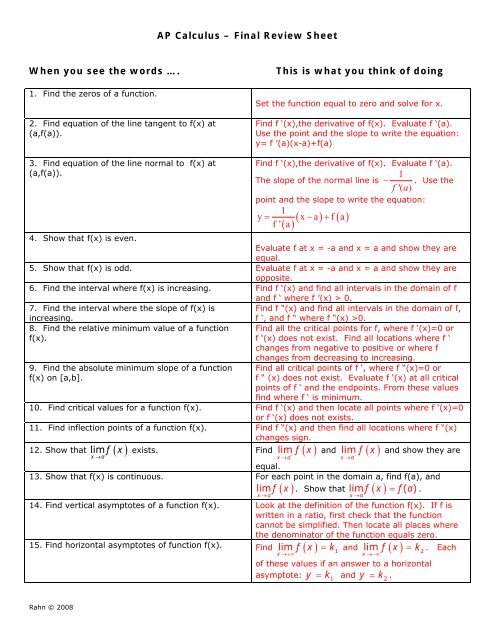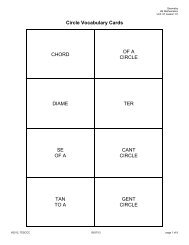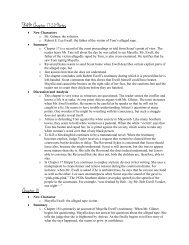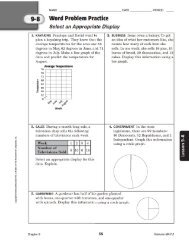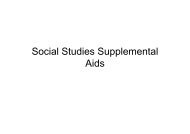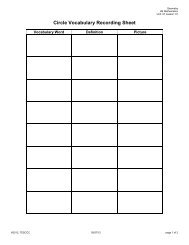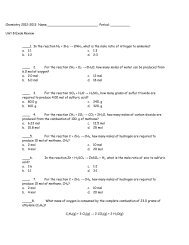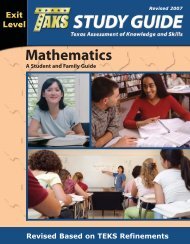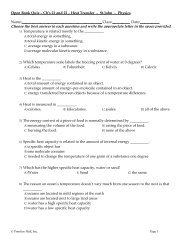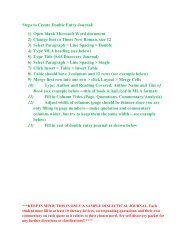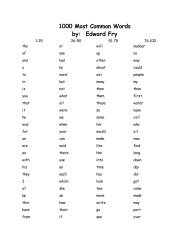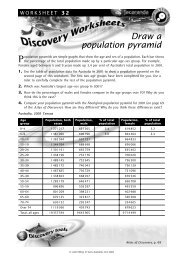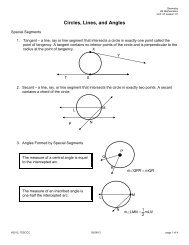AP Calculus – Final Review Sheet When you see the words …. This ...
AP Calculus – Final Review Sheet When you see the words …. This ...
AP Calculus – Final Review Sheet When you see the words …. This ...
- No tags were found...
Create successful ePaper yourself
Turn your PDF publications into a flip-book with our unique Google optimized e-Paper software.
37. Find <strong>the</strong> area bounded by f(x), <strong>the</strong> x-axis,x=1 and x = 10 using 3 trapezoids, where Δx=3. Find f(1), f(4), f(7), and f(10). Use <strong>the</strong>se for <strong>the</strong>bases in finding <strong>the</strong> area of three trapezoids withheights of 3:1 1 1(3)( f(1) + f(4)) + (3)( f(4) + f(7)) + (3)( f(7) + f (10))2 2 238. Approximate <strong>the</strong> area bounded by f(x), <strong>the</strong>x-axis, x=0 and x = 7 using left Reimannsums from information about f(x) given intabular data.x 0 1 5 7f(x) 1 13 16 539. Approximate <strong>the</strong> area bounded by f(x), <strong>the</strong>x-axis, x=0 and x = 7 using right Reimannsums from information about f(x) given intabular data.x 0 1 6 7f(x) -1 -13 -16 -541. Approximate <strong>the</strong> area bounded by f(x), <strong>the</strong>x-axis, x = 0, and x = 14 using two subintervalsand midpoint rectangles from information aboutf(x) given in tabular data.x 0 3 6 10 14f(x) 1 7 12 11 340. Approximate <strong>the</strong> area bounded by f(x), <strong>the</strong>x-axis, x = 0, and x = using threetrapezoids from information about f(x)given in tabular data.x 1 5 6 10f(x) 2 7 12 15Find <strong>the</strong> base, difference between x values, and height(at left hand end) of <strong>the</strong> three rectangles.1 1 + 4 13 + 2 16( ) ( ) ( ) ( ) ( ) ( )Find <strong>the</strong> base, difference between x values, and height(at right hand end) of <strong>the</strong> three rectangles.1 − 13 + 5 − 16 + 1 −5( ) ( ) ( ) ( ) ( ) ( )Find <strong>the</strong> intervals for <strong>the</strong> two rectangles: (0,6) and(6,14). The midpoints are 3 and 10. Find <strong>the</strong> heightof <strong>the</strong> rectangles: 7 and 11 respectively. Find <strong>the</strong>6 7 + 8 11area: ( ) ( ) ( ) ( )Find <strong>the</strong> height of <strong>the</strong> three trapezoids: 4, 1, and 4.Find <strong>the</strong> bases: 2 and 7, 7 and 12, and 12 and 15.Find <strong>the</strong> areas:1 1 1( 4)( 2 + 7) + ( 1)( 7 + 12) + ( 4)( 12 + 15)2 2 242. Given <strong>the</strong> graph of f ‘ (x) >0 between x=0and x = a and f(0) =8, find f(a). = +∫043. Solve <strong>the</strong> differential equation44. Describe <strong>the</strong> meaning of f ()dt tx∫adydx1+xy= .45. Given a base is bounded by x = a, x = b, f(x)and g(x), where f(x) < g(x) for all a
48. Find <strong>the</strong> minimum acceleration given v(t), <strong>the</strong>velocity function.49. Approximate <strong>the</strong> value of f(1.1) by using <strong>the</strong>tangent line to f at x=1.50. Given <strong>the</strong> value of F(a) and <strong>the</strong> fact that <strong>the</strong>anti-derivative of f is F, find F(b). = +∫Find a(t) or <strong>the</strong> derivative of v(t) and a’(t). Find <strong>the</strong>critical points for a(t) from a’(t). Find where a’(t) ischanging from negative to positive (a(t) changingfrom decreasing to increasing). These are locationsfor <strong>the</strong> local minimum accelerations.Write <strong>the</strong> tangent line at x=1.y = f '(1)( x − 1) + f (1) . Use x = 1.1 in this tangentline to find <strong>the</strong> approximate value of f(1.1).bF( b) F( a) f( x)dx51. Find <strong>the</strong> derivative of f(g(x)).( f ( g( x)) ) ' = f '( g( x)) ⋅ g '( x )a52. Given f ( x)dxb∫, find f ( x)ab∫ [ + k]dx53. Given a graph of f ‘(x), find where f(x) isincreasing.54. Given v(t), <strong>the</strong> velocity function, and s(0),<strong>the</strong> initial position, find <strong>the</strong> greatest distancefrom <strong>the</strong> origin of a particle on [0,b].55. Given a water tank with g gallons initially, isbeing filled at <strong>the</strong> rate of F(t) gallons/min andt ,emptied at <strong>the</strong> rate of E(t) gallons/min on [ ]1 ,t 2find <strong>the</strong> amount of water in <strong>the</strong> tank at mminutes where t1 < m < t2.56. Given a water tank with g gallons initially, isbeing filled at <strong>the</strong> rate of F(t) gallons/min andt ,emptied at <strong>the</strong> rate of E(t) gallons/min on [ ]1 ,t 2find <strong>the</strong> rate <strong>the</strong> water amount is changing at m.57. Given a water tank with g gallons initially, isbeing filled at <strong>the</strong> rate of F(t) gallons/min andt ,emptied at <strong>the</strong> rate of E(t) gallons/min on [ ]1 ,t 2find <strong>the</strong> time when <strong>the</strong> water is at a minimum.58. Given a chart of x and f(x) on selectedvalues between a and b, estimate f ‘(c) where c isbetween a and b.ab b b∫⎣⎡ ( ) ⎦⎤∫ ( ) ∫∫f x + k dx = f x dx + kdx =a a abaf( x) dx + k( b − a)From <strong>the</strong> graph of f ‘(x) find where <strong>the</strong> graph is below<strong>the</strong> x-axis. <strong>This</strong> means f ‘(x) is negative. Describe<strong>the</strong>se intervals.Find when v(t) is zero. <strong>This</strong> means <strong>the</strong> function is atrest at <strong>the</strong>se values. Write s(t).tst () s(0) v( xdx. ) Evaluate s(t) at each place= +∫0v(t) is zero. Pick out <strong>the</strong> greatest distance from <strong>the</strong>origin.m∫ ( () − ())t1Ft Et dtF(t)-E(t)Differentiate <strong>the</strong> integral in question 55 with respectto t. <strong>This</strong> will give <strong>you</strong> a rate equation or <strong>the</strong> equationin question 56. Find <strong>the</strong> zeros for F(t)-E(t). Evaluate<strong>the</strong> integral from question 55 at <strong>the</strong>se zero’s and <strong>the</strong>endpoints. Pick out <strong>the</strong> minimum value.Use two sets of points (a, f(a)) and (b, f(b)) near c tof( b) − f( a)evaluate f '( c)≈b − aRahn © 2008
dy59. Given , draw a slope fielddx60. Given that f(x) < g(x). find <strong>the</strong> area betweencurves f(x) and g(x) between x = a and x = b on[a,b].Identify points on <strong>the</strong> graph. Name <strong>the</strong> coordinates of<strong>the</strong>se points. Evaluate dy at <strong>the</strong>se points. Draw adxshort line that represents <strong>the</strong> given slope at thatpoint. The slope field should model <strong>the</strong> slope of afamily of functions whose derivative is dydx .b∫a(( f x) − g( x))dx61. Given that f(x) > g(x). Find <strong>the</strong> volume of <strong>the</strong>solid created if <strong>the</strong> region between curves f(x)and g(x) between x = a and x = b on [a,b]. isrevolved about <strong>the</strong> x-axis.f( a + h) − f( a)62. Find a limit in <strong>the</strong> form lim.h→0h63. Given information about f(x) for x in [a,b],show that <strong>the</strong>re exists a c in <strong>the</strong> interval [a,b],f(b)-f(a)where f '(c) = . b-a64. Given f “ (x) and all critical values of x in(a,b) where f ’(x)=0, determine <strong>the</strong> location of allrelative extrema for f.65. Given f ‘(x) in graphical form on a domain(a,b), determine <strong>the</strong> location of all relativeextrema for f.66. Given that functions f and g are twicedifferentiable, find h ‘(x) if h(x) = f(x)g(x) +k.πb2 2∫ (( ( )) − ( ( )))af x g x dxDetermine <strong>the</strong> value of a and <strong>the</strong> function f.Differentiate f and evaluate at a.Check to <strong>see</strong> that f(x) is continuous on [a,b] anddifferentiable on (a,b). Then <strong>the</strong> Mean Value Theoremguarantees that <strong>the</strong>re exists a c such thatf(b)-f(a)f '(c) = b-aCheck <strong>the</strong> concavity of f at each critical value wheref ‘(x) = 0. If f”(x)>0 <strong>you</strong> have found <strong>the</strong> location of aminimum. If f”(x)


